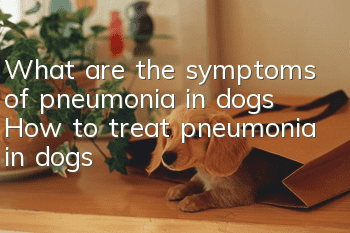What are the symptoms of pneumonia in dogs? How to treat pneumonia in dogs

Beware of dog pneumonia during seasonal changes. Treatment of canine bronchopneumonia. Bronchopneumonia is an inflammation of individual lobules or several pulmonary lobules, also known as lobular pneumonia; the alveoli are usually filled with inflammatory exudative components composed of epithelial cells, plasma and white blood cells. Clinically, the symptoms include relaxing fever, increased breathing frequency, cough, and localized pneumonia lesions in the lungs.
(1) Secondary colds, improper feeding and management, stimulation by physical and chemical factors, and low synthetic resistance create opportunities for various bacteria, such as pasteurella, pneumococci, streptococci, staphylococci and other infections .
(2) Parasitic cause: Ascaris larvae damage the alveoli and bronchi during their migration in the body.
(3) Secondary factors, such as colds, adenovirus, canine distemper, infectious hepatitis and inflammatory transfer to other tissues and organs, can all lead to pneumonia.
【Symptoms】
The disease initially showed symptoms of acute bronchitis, including runny nose, dry cough, and bronchial sounds. As the disease progresses, the general condition worsens, the spirit becomes depressed, the appetite decreases or no food is eaten, the body temperature rises to 39.54 degrees, the symptoms are flaccid fever, dyspnea, increased frequency, conjunctival cyanosis, sunken eyeballs, and dehydration.
During auscultation of the lungs, the alveolar sounds are weakened in the diseased areas, crepitus can be heard, and sounds can be heard in the healthy parts.
Blood changes, total white blood cell count and neutrophils increased, and there was left nuclear shift. X-ray examination shows that the lung texture is thickened and has flaky shadows.
【Treatment】
(1) Penicillin 50,000 units/kg body weight, streptomycin 30,000 units/kg body weight, dexamethasone 0.1-0.3 mg/kg body weight, mixed and injected intramuscularly, twice a day, for 5-7 days.
(2) Tetracycline 10-15 mg/kg body weight, dissolved in 5% glucose, intravenously injected, 2 times/day. Or cephalosporin 56 mg/kg body weight, dexamethasone 0.2 mg/kg body weight, mixed intramuscular injection, 2 times/day.
(3) Supportive therapy, 5% glucose saline 15-30 ml/kg body weight, 5% sodium bicarbonate injection 1-2 ml/kg body weight, mixed intravenous infusion.
(4) Fatan antitussive, ammonium chloride 50 mg/kg body weight, Kebiqing 2.5 mg/kg body weight, taken orally 2 times/day. To relieve asthma, aminophylline 10-15 mg/kg body weight can be taken orally 2 times a day.
(5) When you have difficulty breathing and heart failure, take ephedrine orally. 5-15 mg each time. Aminophylline, 10 mg per kilogram of body weight, administered or intravenously, once every 8 hours. For those with difficulty breathing causing hypoxia, oxygen inhalation should be given. For those with anorexia, intravenous injections are given to replenish body fluids and nutrients.keep.
- What are the common intestinal parasites in dogs? How much do you know?
- How to train a Border Collie to walk? A few steps to teach you!
- How to train a pet dog to understand human speech? Come and take a look!
- How to train a dog to be a police dog? The dog’s performance is unexpected!
- Prevention and treatment of common summer diseases in German Shepherds!
- Why do dogs have bloody stools? Several common reasons why dogs have loose stools and bloody stools!
- Which of the dog’s private behaviors are normal and which are abnormal?
- How to train Eurasian dogs to be obedient
- What medicine is better for dogs with suppurated skin?
- Pets keep scratching their mouths, beware of foreign objects stuck in the esophagus



